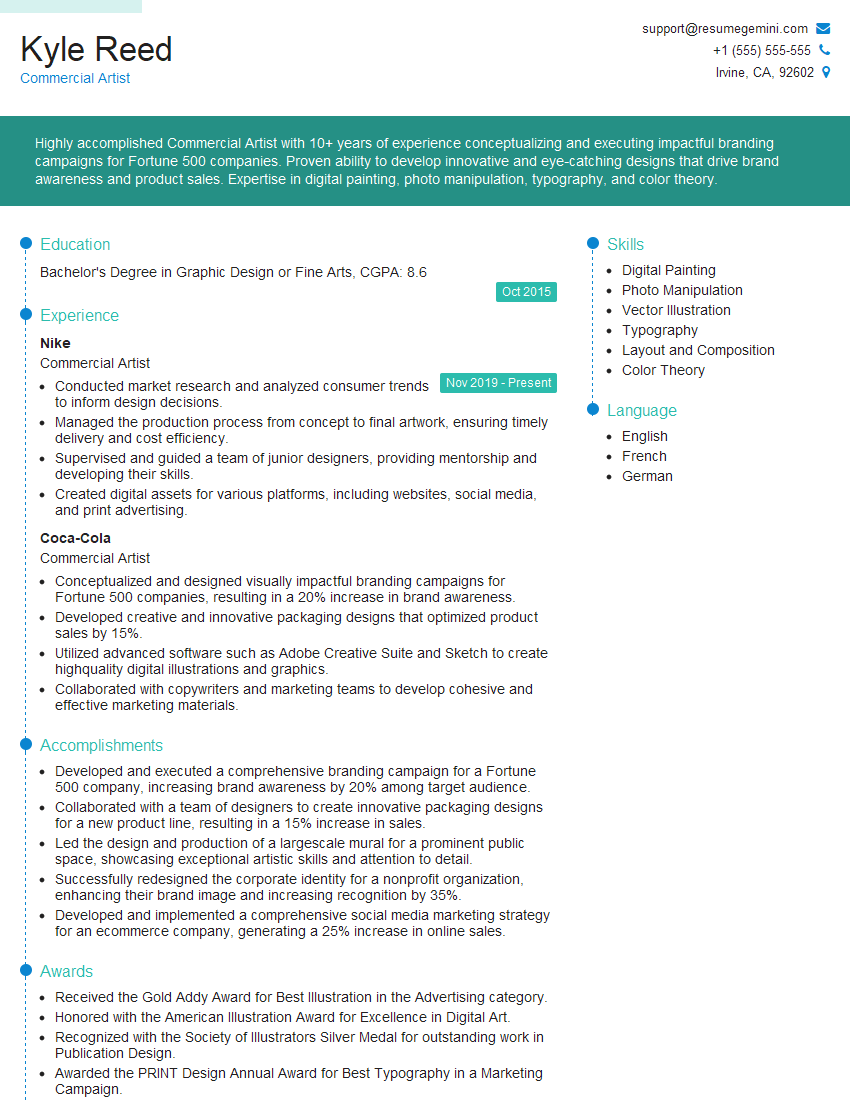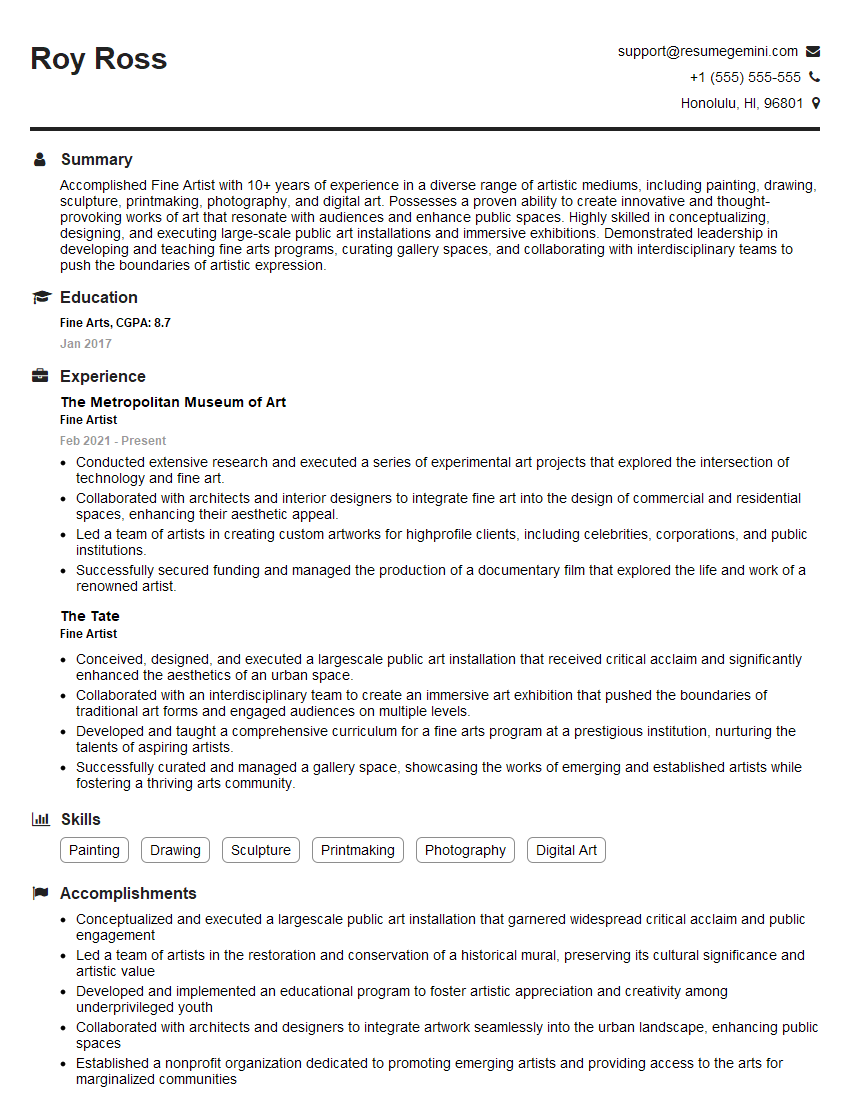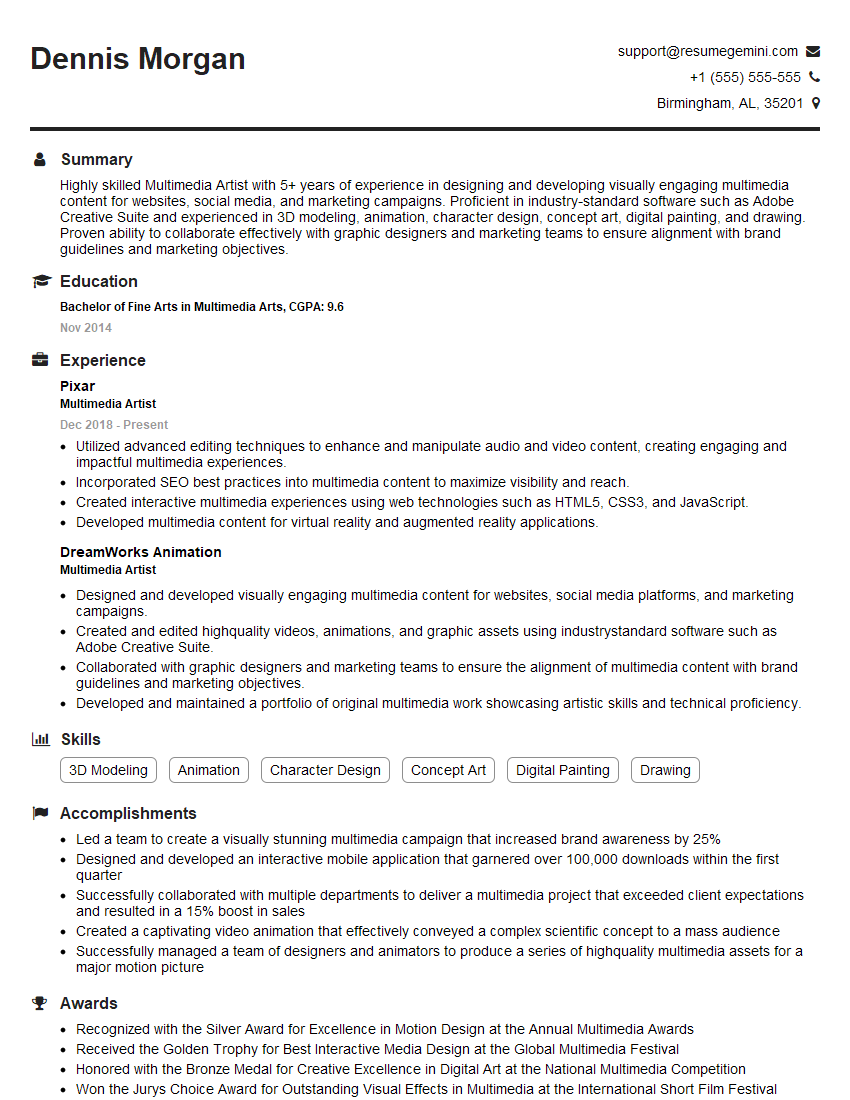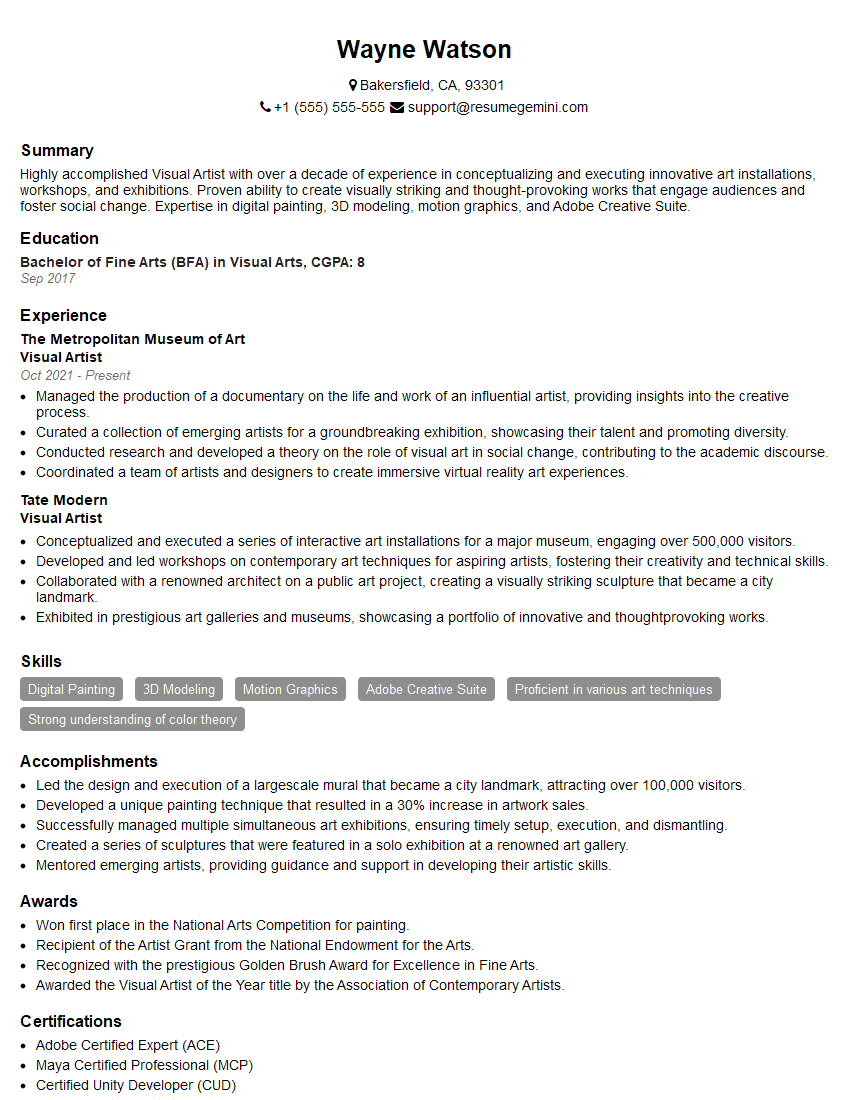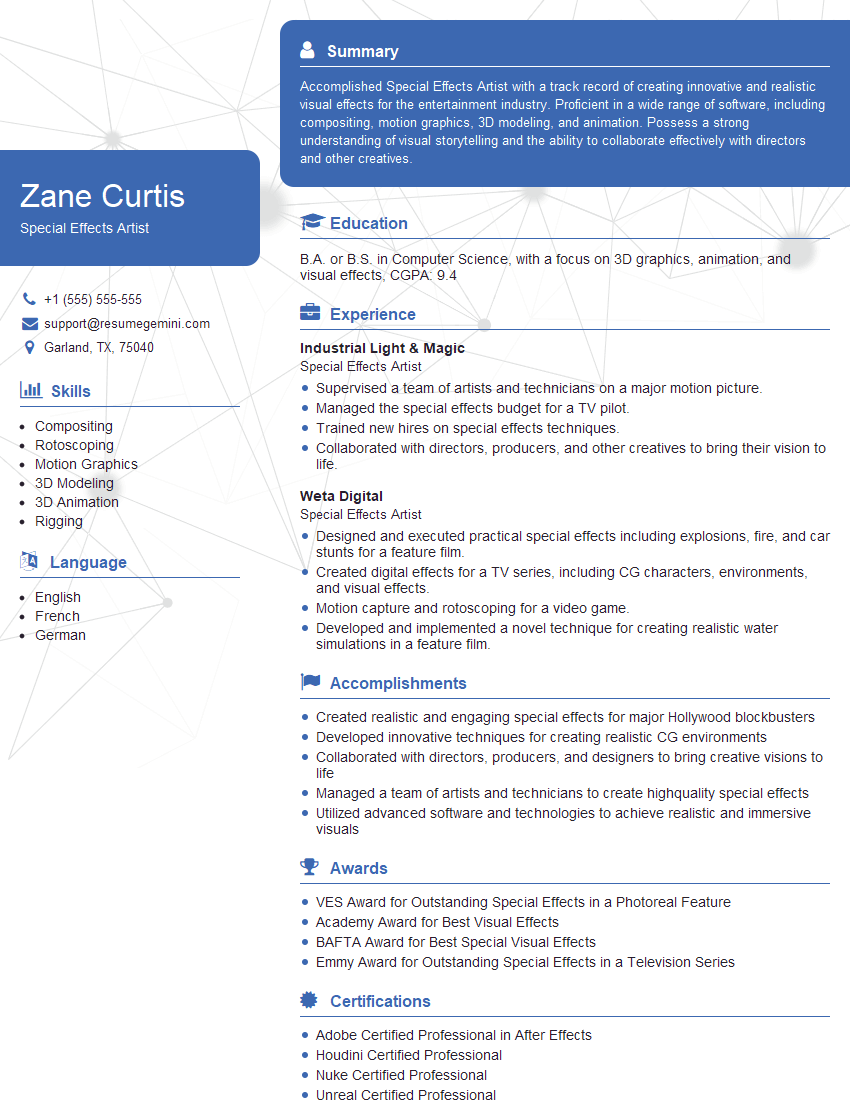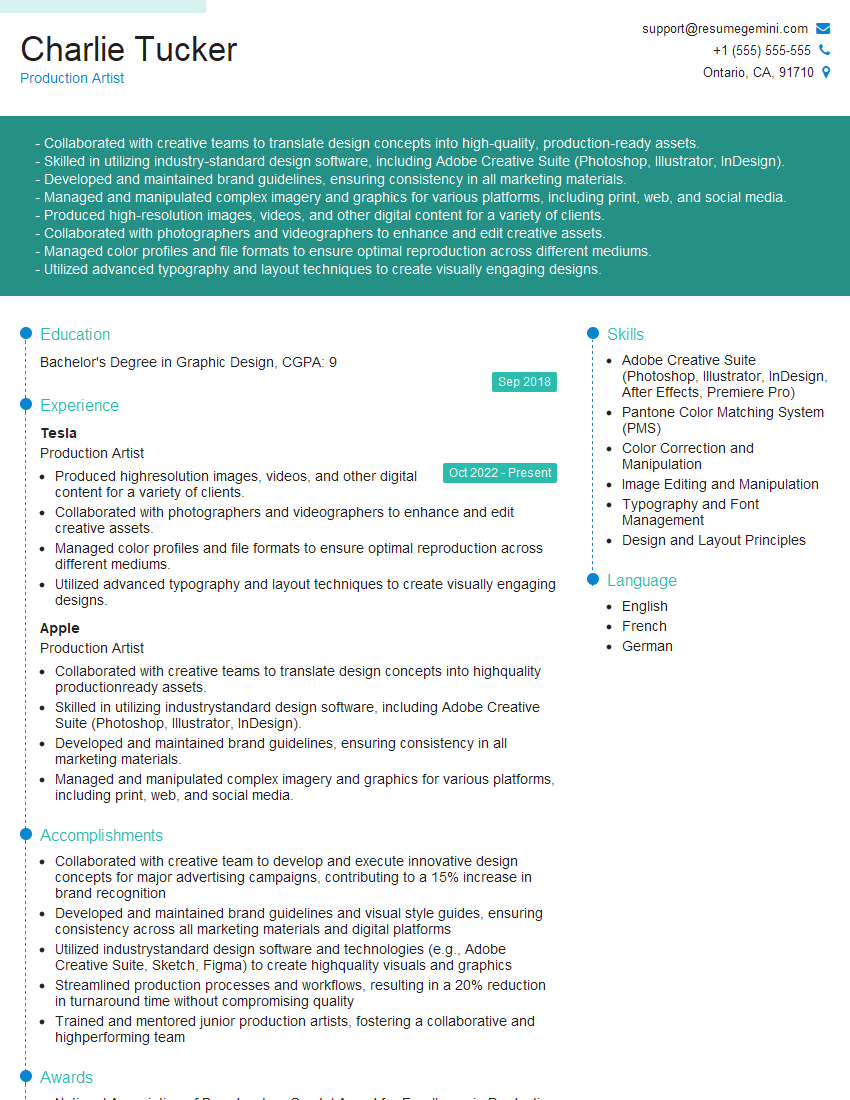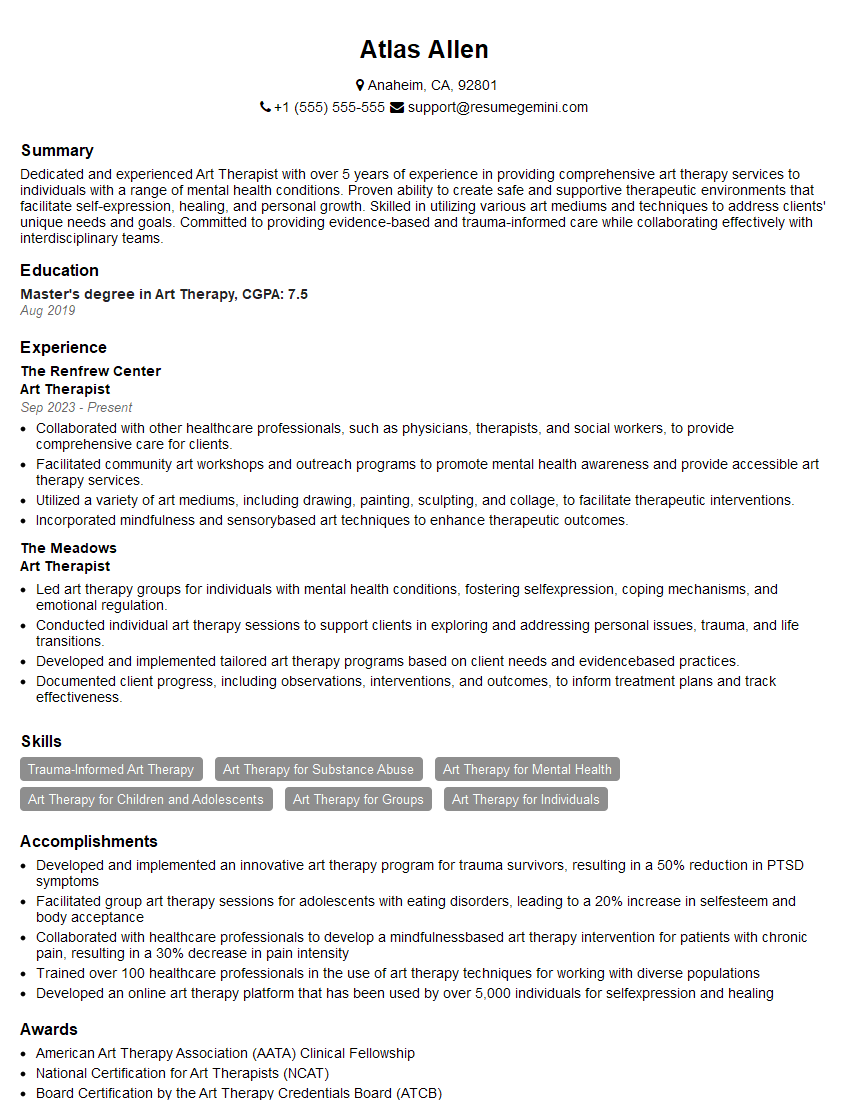The thought of an interview can be nerve-wracking, but the right preparation can make all the difference. Explore this comprehensive guide to Acrylic Paint interview questions and gain the confidence you need to showcase your abilities and secure the role.
Questions Asked in Acrylic Paint Interview
Q 1. Explain the difference between acrylic and oil paints.
Acrylic and oil paints differ fundamentally in their binder – the substance that holds the pigment together. Oil paints use drying oils, like linseed oil, which take days or even weeks to dry completely. This slow drying time allows for extensive blending and layering, creating rich, luminous effects. Acrylic paints, on the other hand, use a water-based acrylic polymer emulsion as a binder. This dries very quickly, usually within minutes to hours, depending on the thickness of the application and environmental conditions. This rapid drying time offers advantages in terms of speed and cleanup, but it also limits blending possibilities.
Think of it like this: oil painting is like working with a slow-setting clay, allowing for gradual shaping and adjustments. Acrylic painting is more like working with fast-setting cement – quick, decisive, and less forgiving of mistakes.
Q 2. Describe your preferred method for mixing acrylic colors.
My preferred method for mixing acrylic colors is to use a limited palette approach, meaning I start with a few primary and secondary colors and mix my desired hues from there. I usually start by mixing smaller amounts on my palette, gradually increasing the quantity as I find the perfect tone. I favor a ‘wet-on-wet’ technique where I blend directly on the canvas. However, sometimes it is better to premix on the palette for larger areas or consistent color across the painting. I always clean my palette between colors to avoid unintended mixing.
For example, if I need a specific shade of green, I would carefully measure small amounts of blue and yellow, mixing incrementally until I achieve the desired saturation and hue. I always test the color on a scrap piece of canvas before applying it to the main painting. This avoids unpleasant surprises later in the process.
Q 3. What are the advantages and disadvantages of using acrylic paints?
Acrylic paints offer many advantages, making them a popular choice for artists of all skill levels. They are water-based, making cleanup incredibly easy – just soap and water! They are also versatile, adhering well to a variety of surfaces, including canvas, wood, paper, and even fabric. Their fast drying time is a significant advantage for those who prefer working quickly. Acrylics are also relatively inexpensive compared to oil paints.
However, acrylics also have some drawbacks. The rapid drying time can be a hindrance for techniques requiring extended blending. The quick drying can also lead to visible brushstrokes if not applied smoothly. Finally, while some acrylics are lightfast, meaning they don’t fade over time, the quality varies greatly depending on the brand, so choosing a reputable brand is crucial.
Q 4. How do you achieve different levels of opacity and transparency with acrylics?
Controlling opacity and transparency in acrylic painting is achieved primarily by adjusting the paint’s consistency and application technique. For opaque coverage, you apply a thicker layer of paint directly onto the canvas. For transparent or semi-transparent washes, dilute the paint with water or a glazing medium. A higher water-to-paint ratio creates a more transparent effect, allowing underlying layers to show through.
Think of it like watercolor: a thick application will be opaque, while a thin wash will be transparent. You can also layer transparent washes to gradually build up color and depth. Experimentation is key here; starting with a small test area to see how the dilution impacts opacity helps avoid unexpected results on the main painting.
Q 5. Explain your process for preparing a canvas for acrylic painting.
Preparing a canvas for acrylic painting involves several important steps to ensure the paint adheres properly and the painting lasts. First, I inspect the canvas for any imperfections. If there are any knots or bumps, I might sand them down. Then, I usually apply a gesso primer. Gesso creates a smooth, even surface, improving the paint’s adherence and preventing it from absorbing into the canvas too quickly. This also helps prevent the canvas from warping. Two or three thin coats are better than one thick coat, allowing each layer to dry fully before applying the next.
After the gesso is completely dry, I lightly sand it with fine-grit sandpaper to ensure a smooth finish. Finally, I wipe the canvas with a clean, slightly damp cloth to remove any dust particles before I start painting. Preparing the canvas might seem like an extra step, but this vital process sets the stage for a successful painting.
Q 6. How do you handle the drying time of acrylic paints?
The fast drying time of acrylics can be both a blessing and a curse. To manage this, I employ several strategies. I work in smaller sections, completing one area before moving on to the next. This ensures that previously painted areas don’t dry completely before I’m ready to blend or layer. I also use a palette that maintains moisture, sometimes keeping a damp sponge or towel nearby. Using retarder medium can significantly slow down the drying time, offering more working time for blending and layering. I might also use a spray bottle to mist the paint periodically to keep it workable.
In warmer, drier climates, I pay even more attention to maintaining moisture and working quickly. My approach is flexible and depends on the painting, the environment, and my personal preferences, always ensuring that the painting process isn’t rushed or compromised by overly rapid drying.
Q 7. What are some common mediums used with acrylic paints, and how do they affect the paint?
Various mediums are available to modify the properties of acrylic paints. Retarder medium, as mentioned earlier, slows down drying time. Gel medium adds texture and body, perfect for impasto techniques (thick application of paint). Glazing medium creates transparent layers, allowing for luminous effects. There are also matte and gloss mediums to adjust the final sheen of the painting.
For instance, if I’m aiming for a heavily textured impasto painting, I would liberally mix the paint with gel medium. If I’m creating a series of fine, transparent washes, I would use a glazing medium. The right medium can significantly enhance the final result, offering additional control and creative possibilities beyond what the paint alone can achieve.
Q 8. Describe your techniques for creating different textures with acrylics.
Creating diverse textures with acrylics is all about manipulating the paint’s consistency and application method. Think of it like sculpting with color!
Thick Impasto: For a heavily textured, almost three-dimensional effect, use the paint straight from the tube or add minimal medium. Apply it thickly with a palette knife or even a brush loaded heavily with paint. This technique is fantastic for creating strong brushstrokes and adding visual interest to landscapes or portraits.
Thin Washes: To achieve a delicate, transparent layer, dilute the acrylics with water or a glazing medium. This creates a smooth, almost watercolor-like effect, perfect for layering and creating depth. I often use washes to build up atmospheric perspective in landscapes.
Dry Brushing: Load a stiff-bristled brush with very little paint and drag it across the canvas. This technique creates a scratchy, textured effect, excellent for representing weathered surfaces like wood or stone. I’ve used this successfully to depict old, crumbling buildings.
Adding Texture Mediums: Incorporating mediums like texture paste, modeling paste, or gesso adds significant texture. These mediums can be applied directly to the canvas or mixed with the paint. This opens up a world of possibilities, from creating raised details to incorporating sand or other materials for even more complex textures.
Sponging and Stamping: Use sea sponges, stencils, or homemade stamps to apply paint in unique patterns. This method is very effective for creating organic or repeating textures. I once used a sponge to create a beautiful cloud effect in a sky.
Q 9. How do you clean your brushes and palettes after using acrylic paints?
Cleaning acrylics is crucial for maintaining brush quality and preventing color mixing. The key is speed – acrylics dry quickly!
Brushes: Immediately after painting, rinse brushes under warm, running water. Gently work the paint out of the bristles. Use a brush soap or mild dish soap if needed. Reshape the bristles and lay them flat to dry. Avoid leaving brushes soaking in water, as this can damage the handles.
Palettes: If using disposable palettes, simply discard them once finished. For reusable palettes, wipe off excess paint immediately. A wet wipe or paper towel can remove most wet paint. For stubborn residue, warm soapy water and a sponge are effective.
Remember: prevention is key! Keep a small container of water nearby and rinse your brushes frequently during your painting session.
Q 10. Explain your process for layering acrylic paints.
Layering acrylics builds depth and complexity. It’s like building a painting in layers, revealing more with each addition.
Underpainting: Start with a base layer – a thin, toned layer to establish the overall composition and color scheme. This can be a monochromatic wash or a simple color block.
Mid-tones: Add intermediate layers to define forms and details, gradually building up values and colors. I often use thin washes during this stage to retain some of the underpainting’s luminosity.
Highlights and Shadows: Apply lighter colors for highlights and darker colors for shadows to create volume and depth. This involves careful observation and an understanding of light and shadow interaction.
Glazing: Apply thin, transparent layers of color over a dried underpainting. This technique subtly alters the color and creates luminosity. It’s like applying a veil of color to enhance the existing work.
Allowing Drying Time: Always ensure each layer is completely dry before applying the next to prevent muddying of colors and ensure proper adhesion.
The number of layers depends on the complexity of the artwork. Some paintings may only require a few, while others might have many.
Q 11. How do you create smooth gradients and blends with acrylic paints?
Creating smooth gradients and blends with acrylics requires careful planning and technique. The key is keeping the paint wet and working quickly.
Wet-on-Wet Blending: Apply adjacent colors while they are still wet, gently blending them together with a brush or palette knife. This is the most common and effective method. A soft brush is particularly useful here.
Using a Medium: A glazing medium or retarder can slow down the drying time of acrylics, allowing for more extended blending time. These mediums thin the paint, allowing for a smoother transition.
Layering Thin Washes: Apply multiple thin washes of gradually shifting colors to create a smooth gradient. This method offers more control and allows for nuanced color changes.
Using a Palette Knife: A palette knife is ideal for blending larger areas and achieving a smoother finish, especially in impasto styles.
Practice is essential! Experiment with different techniques to find what works best for you and the specific effect you’re aiming for.
Q 12. What are some techniques for achieving impasto effects with acrylics?
Impasto, the application of thick paint, adds a dramatic, three-dimensional quality to a painting. It is a powerful way to express texture and energy.
Thick Application: Use a palette knife or a stiff-bristled brush to apply a significant amount of undiluted acrylic paint directly to the canvas. Don’t be afraid to build up the paint in layers.
Using Impasto Mediums: Impasto mediums, often gel-like in consistency, can be added to the paint to increase its viscosity and further enhance the texture. They help hold their shape, making the brushstrokes more defined.
Textured Surfaces: By applying the paint thickly, you create texture that reflects light differently, adding depth and dimension to the canvas.
Palette Knife Techniques: A palette knife allows for controlled application of thick paint, creating various textures like swirls, peaks, and ridges. Experiment with different knife movements to achieve your desired effect.
The key with impasto is to let the paint do the work. The textural details often speak louder than overly precise brushwork.
Q 13. How do you fix mistakes or correct errors in your acrylic paintings?
Making mistakes is part of the creative process. Fortunately, acrylics offer several methods for correction.
Scrape it off: If the paint is still wet, you can carefully scrape it off using a palette knife. This is very effective for removing large areas of unwanted paint.
Wipe it off: Use a damp cloth or paper towel to gently lift away wet or slightly tacky paint. Be careful not to damage the surrounding areas.
Repaint the area: Once the affected area is completely dry, simply repaint it with the correct colors and techniques. This might involve integrating the correction into the overall painting.
Use a White Base: Applying a layer of white acrylic paint to an area can provide a clean base for repainting, especially for drastic corrections.
Blend it in: If a smaller correction is needed, you might try to blend the mistake into the surrounding areas using thin washes or careful brushstrokes. This takes more skill and might not always be successful.
Remember, some mistakes can become interesting features. Don’t be afraid to experiment and learn from your errors!
Q 14. Describe your experience with various acrylic paint brands.
Over the years, I’ve worked extensively with various acrylic paint brands, each possessing its own unique characteristics.
Liquitex: Known for its vibrant colors, high pigment concentration, and excellent lightfastness. I particularly appreciate their professional range for its consistency and versatility.
Golden: This brand offers a wide selection of high-quality paints and mediums. Their fluid acrylics are fantastic for washes and blending, while their heavy body paints are ideal for impasto work. I admire their innovative approach to new mediums.
Winsor & Newton: A reputable brand known for its artist-grade paints, offering exceptional color strength and permanence. They are known for their precise color matching and professional-grade properties.
Amsterdam: A good balance of quality and price. They offer a strong range of colors suitable for various projects. I often use them for student projects or large canvases where the cost is a consideration.
Ultimately, the best brand depends on individual preferences and the specific project. I often use a combination of brands to achieve the desired results, selecting specific colors or mediums based on their individual properties.
Q 15. How do you handle cracking or peeling in acrylic paintings?
Cracking and peeling in acrylic paintings are usually caused by insufficient preparation or improper application. Think of it like building a house – a weak foundation will lead to problems later. In acrylics, this ‘foundation’ is the surface preparation and the layering technique.
Insufficient Priming: An unprimed canvas or a poorly primed surface is a major culprit. The paint lacks proper adhesion, leading to cracking as the paint layer expands and contracts with temperature and humidity changes. Imagine trying to stick wallpaper to a rough, uneven wall – it won’t adhere properly.
Thick Layers: Applying excessively thick layers of acrylic paint without allowing sufficient drying time between layers can cause stress within the paint film, leading to cracking. It’s like piling wet clay too high – it will crack as it dries.
Incompatible Materials: Using incompatible materials, such as applying acrylics over an oil-based underpainting, can also lead to issues. Oil and acrylic don’t mix well and the different drying times can cause problems.
Solutions:
Proper Priming: Always properly prime your canvas or surface with an acrylic gesso. This creates a smooth, even surface that ensures good adhesion.
Thin Layers: Apply thin layers of paint, allowing each layer to dry completely before applying the next. This minimizes stress on the paint film and reduces cracking.
Flexible Mediums: Incorporating a flexible medium into your paint can improve its flexibility and reduce cracking. These mediums can help the paint move with the underlying surface.
Addressing Existing Cracks: If cracking has already occurred, you might be able to carefully repair it by gently cleaning the area, applying a suitable adhesive, and then repainting.
Career Expert Tips:
- Ace those interviews! Prepare effectively by reviewing the Top 50 Most Common Interview Questions on ResumeGemini.
- Navigate your job search with confidence! Explore a wide range of Career Tips on ResumeGemini. Learn about common challenges and recommendations to overcome them.
- Craft the perfect resume! Master the Art of Resume Writing with ResumeGemini’s guide. Showcase your unique qualifications and achievements effectively.
- Don’t miss out on holiday savings! Build your dream resume with ResumeGemini’s ATS optimized templates.
Q 16. What are some methods for preserving and protecting acrylic paintings?
Preserving and protecting acrylic paintings involves a multi-faceted approach, ensuring their longevity and vibrancy. It’s like preserving a historical document—you need to protect it from the elements and time.
Varnish: Applying a high-quality archival varnish is crucial. Varnish protects the paint from UV damage, dirt, and moisture. It’s analogous to applying a sealant to wood to protect it from the weather.
UV Protection: Keep the painting away from direct sunlight. UV rays degrade the pigments over time, leading to fading and discoloration. Imagine leaving a piece of fabric in the sun – it’ll fade.
Proper Framing and Mounting: Use acid-free materials for framing and mounting. Acidic materials can damage the paint and canvas over time. This is like keeping archival documents in acid-free folders.
Environment Control: Store the painting in a stable environment, with consistent temperature and humidity. Fluctuations can cause the paint to expand and contract, potentially leading to damage. It’s like keeping a delicate instrument in a climate-controlled environment.
Regular Cleaning: Dust regularly using a soft brush or a microfiber cloth. Avoid using harsh chemicals or abrasive materials. Think of gently cleaning a delicate piece of jewelry.
Q 17. Describe your understanding of color theory and its application in acrylic painting.
Color theory is the foundation of successful acrylic painting. It’s understanding the relationships between colors and how they interact to create specific effects. It’s like understanding musical notes – they can create harmony or dissonance depending on how they are combined.
Color Wheel: The color wheel is a visual representation of color relationships. It shows primary, secondary, and tertiary colors, and how they relate to each other through hue, saturation, and value (or brightness). Understanding this wheel is essential for mixing colors effectively.
Complementary Colors: Colors opposite each other on the color wheel are complementary. When used together, they create a vibrant and contrasting effect. Think of the deep blue of the ocean contrasting with the bright orange of a sunset.
Analogous Colors: Colors adjacent to each other on the color wheel are analogous. They create a harmonious and subtle effect. Think of the soft hues of a pastel landscape.
Warm and Cool Colors: Warm colors (reds, oranges, yellows) tend to advance, while cool colors (blues, greens, purples) tend to recede. This can be used to create depth and perspective in a painting. Imagine a warm foreground contrasted with a cooler background.
Value and Saturation: Adjusting the value (lightness or darkness) and saturation (intensity) of colors can significantly alter the mood and impact of a painting. A painting with muted values can feel calm and serene, while one with high saturation can feel energetic and vibrant.
In my work, I consciously use color theory to evoke specific emotions and create visual interest. For example, I might use complementary colors to create a dynamic focal point, or analogous colors to create a sense of harmony and tranquility.
Q 18. Explain your approach to composition and design in your acrylic artwork.
Composition and design are the structural elements that create a successful artwork. They are the scaffolding that supports the artistic vision. It’s like architectural design; a well-thought-out plan is necessary to create a stable and visually appealing structure.
Rule of Thirds: I often use the rule of thirds, which divides the canvas into nine equal parts and places key elements along these lines or at their intersections. This creates a more visually appealing and balanced composition than centering everything.
Leading Lines: Directing the viewer’s eye through the use of lines, shapes, and colors is crucial. This helps guide the viewer through the painting and create a sense of movement.
Focal Point: Every painting needs a focal point—the area that first captures the viewer’s attention. This could be achieved through contrast, color, or size.
Balance and Harmony: Achieving a balance between different elements – shapes, colors, and textures – is essential for creating a visually harmonious painting.
Negative Space: The empty space around the subject matter is just as important as the subject itself. Negative space helps to define the subject and create visual breathing room.
My approach to composition is often intuitive, guided by a sense of balance and flow. However, I always consciously consider these design principles to ensure a strong and effective composition.
Q 19. How do you develop your artistic ideas and translate them into acrylic paintings?
Developing artistic ideas and translating them into acrylic paintings is a process that involves inspiration, experimentation, and refinement. It’s a journey, not a destination.
Inspiration: My ideas come from a variety of sources – nature, personal experiences, emotions, even dreams! I keep a sketchbook to jot down ideas, sketches, and color palettes.
Research and Exploration: Once I have a general idea, I do research—looking at other artists’ work, exploring different techniques, and experimenting with different materials.
Sketching and Planning: I create detailed sketches to plan the composition, color palette, and overall design of the painting. This helps me to visualize the final result before I start painting.
Execution and Refinement: The actual painting process involves layering, blending, and adjusting colors and values. I often work in stages, constantly evaluating and refining the painting until I feel it’s complete.
For example, a recent piece was inspired by a walk in the woods after a rain shower. I sketched various elements, experimented with color palettes, and ultimately created a painting that conveyed the mood and atmosphere of that experience.
Q 20. What are some common challenges you encounter when working with acrylics, and how do you overcome them?
Working with acrylics presents unique challenges, but knowing how to tackle them is key to success. It’s like learning any skill; practice and understanding the material’s limitations are paramount.
Drying Time: Acrylics dry quickly, which can be both an advantage and a disadvantage. It’s challenging to blend colors smoothly if they dry too quickly. Solution: I use retarders to slow down the drying time, allowing more time for blending.
Opacity and Transparency: Acrylics can be both opaque and transparent, depending on the pigment and the amount of medium used. Controlling this is vital for achieving the desired effect. Solution: I carefully adjust the amount of water or medium to control the opacity and transparency.
Clean-up: Acrylics are water-based but can be difficult to completely remove from brushes and palettes if allowed to dry. Solution: I clean my brushes immediately with water and soap.
Color Shifts: The color of acrylics can shift slightly as they dry. Solution: I take this into account when mixing colors and paint test swatches to understand how the color will change.
Q 21. Describe your experience with different acrylic painting surfaces (canvas, wood panel, etc.).
I’ve worked with various surfaces, each having its unique properties and requiring a different approach. It’s like choosing the right tool for the job; different surfaces demand different techniques.
Canvas: The most common surface, offering a flexible and absorbent base for acrylics. I prefer cotton canvases for their texture and absorption capabilities.
Wood Panels: Wood panels offer a rigid and stable surface, ideal for detailed work. They require priming to ensure good adhesion for the acrylics.
Paper: Suitable for sketching and smaller works, but requires a heavier-weight paper and potentially sizing to prevent the paint from soaking into the paper too much.
Other Surfaces: I’ve also experimented with painting on fabric, glass, and even metal, each requiring specific preparations and considerations.
The choice of surface affects not only the texture and feel of the finished painting but also the painting process itself. I always select the surface that best suits the specific artistic vision and technique I plan to use.
Q 22. How do you adapt your painting style to different projects or commissions?
Adapting my painting style to different projects hinges on understanding the client’s vision and the inherent characteristics of the project itself. For example, a whimsical children’s book illustration demands a looser, more playful style compared to a realistic portrait commission which requires meticulous detail and precise rendering. I begin by thoroughly analyzing the project brief, mood board (if provided), and reference images. This helps me determine the appropriate color palette, brushwork techniques, and overall level of detail. For a landscape commission, I might focus on achieving a sense of depth and atmosphere using layering techniques and glazing. In contrast, an abstract piece might involve experimenting with impasto (thick application of paint) and palette knife techniques to create texture and movement.
For instance, I recently completed a commission for a corporate client requiring a sophisticated, minimalist design. I shifted from my usual expressive brushstrokes to clean lines and a limited palette of cool, muted tones. Conversely, when painting a vibrant mural for a children’s play area, I embraced bold colours, dynamic compositions, and playful elements in my style.
Q 23. Explain your experience with different types of brushes and their suitability for acrylics.
My experience with acrylic brushes is extensive, encompassing a wide variety of shapes, sizes, and bristle types. The choice of brush significantly impacts the final result. Synthetic brushes are generally my go-to for acrylics due to their durability and ability to hold the paint well without absorbing too much. Round brushes excel in fine details and creating delicate lines; they are invaluable for rendering hair, eyes, or intricate designs. Flat brushes are ideal for broad strokes, creating washes, and achieving a smooth, even surface. Filbert brushes, with their rounded edges, provide versatility; they’re great for blending and creating soft transitions between colors. Angular brushes, with their sharp point and angled edge, are perfect for sharp lines, creating foliage or textured effects.
For example, when painting a realistic portrait, I might start with larger flat brushes for blocking in the main forms and gradually transition to smaller round brushes for detailed work like rendering the eyes or hair. In contrast, when creating an abstract piece, I might use palette knives or even unconventional tools like sponges or textured cloths to achieve interesting effects. It’s crucial to understand the capabilities of each brush type to master the art of acrylic painting.
Q 24. How do you maintain consistency in color mixing throughout a large painting?
Maintaining color consistency across a large painting is critical. I address this challenge through a multi-pronged approach. Firstly, I always mix larger batches of my base colors and store them in clearly labeled containers to ensure consistent access throughout the painting process. Secondly, I work in sections and create a small color chart with numbered samples, referenced directly from my mixed colors. This chart serves as my reference for maintaining consistency. Finally, I rely heavily on good lighting and routinely compare my work to my color chart. This enables me to identify and adjust any inconsistencies before they become more significant problems.
A practical example is when painting a landscape, I would initially mix a range of greens (light, medium and dark) in larger quantities. As I work on different sections (trees, fields, distant hills), I refer back to my numbered color chart to ensure the greens remain harmonious and consistent throughout the entire landscape.
Q 25. Describe your approach to achieving a specific color or tone in your acrylic paintings.
Achieving a specific color or tone in acrylics relies heavily on understanding color theory and skillful mixing. Starting with a base color, I systematically add other colors to achieve the desired hue, value, and saturation. If I need a specific shade of blue, for example, I might start with ultramarine blue as a base and carefully add small amounts of white to lighten it, black to darken it, or a touch of yellow or red to shift its hue. Experimentation is key. I often create a small color study to test different color combinations before applying them to the main canvas.
For instance, if I want a rich, deep crimson, I’d likely begin with cadmium red and gradually add a touch of alizarin crimson and maybe a hint of black to deepen its value and intensity. This iterative process of adjusting and refining is vital for achieving precise color matching.
Q 26. What are some innovative techniques or approaches you have used with acrylic paint?
I’ve incorporated several innovative techniques into my acrylic painting practice. One such technique involves using stencils and masking fluid to create clean, sharp lines and interesting patterns. This is particularly useful for achieving geometric effects or detailed imagery. I’ve also experimented with applying layers of acrylic washes with water-based mediums to achieve luminous, almost watercolor-like effects. This is quite different from the typical opaque nature of acrylics. Further, exploring mixed media, incorporating materials like collage elements (fabric, paper), or textures (sand, plaster), adds another dimension to my work. This offers a unique textural contrast against the smooth surface of the acrylics.
For example, in a recent abstract work, I used a stencil to create a geometric base and then added layers of transparent washes to create depth and complexity. I then incorporated textured collage elements to give the piece a tactile, multi-dimensional feel.
Q 27. How do you stay up-to-date with current trends and techniques in acrylic painting?
Staying current in the dynamic field of acrylic painting requires continuous learning and engagement. I regularly attend workshops and conferences hosted by renowned artists. These events provide invaluable opportunities to learn new techniques, explore different approaches, and network with other professionals. I also actively follow prominent artists and art publications on social media and subscribe to art magazines. This keeps me informed about emerging trends and advancements. Critically, I actively experiment myself, frequently trying new materials, techniques, and approaches in my own studio practice.
Recently, I attended a workshop focusing on the use of pouring techniques with acrylics, and this significantly broadened my understanding of creating unique textures and colors. My continuous experimentation and exploration of information allow me to stay ahead of the curve.
Q 28. Describe your experience teaching or mentoring others in acrylic painting techniques.
I have considerable experience teaching and mentoring others in acrylic painting. I’ve led several workshops for both beginners and intermediate students. My approach focuses on building a strong foundation in color theory, brushwork techniques, and composition principles. I believe in a hands-on, supportive learning environment where students can experiment, learn from their mistakes, and discover their unique artistic voice. I tailor my instruction to each student’s individual skill level and learning style. For example, I might offer more structured guidance to beginners, while providing more open-ended mentorship to advanced students.
I find that providing detailed demonstrations coupled with individual feedback is highly effective. Observing students work, addressing their challenges, and offering personalized suggestions creates a supportive environment for growth. A successful mentoring experience I recall involved guiding a student who initially struggled with color mixing. By breaking down the process and providing tailored exercises, she eventually mastered color blending and produced her most impressive painting to date.
Key Topics to Learn for Acrylic Paint Interview
- Acrylic Paint Properties: Understanding pigment concentration, binder properties (acrylic polymer), and the effects of different mediums on consistency and drying time.
- Color Theory and Mixing: Mastering color mixing techniques, understanding color relationships (primary, secondary, tertiary), and achieving desired hues and values.
- Application Techniques: Exploring various brushstrokes, layering methods (wet-on-wet, wet-on-dry), impasto techniques, and the use of palette knives for texture creation.
- Surface Preparation and Priming: Knowing the importance of preparing different surfaces (canvas, wood, paper) and selecting appropriate primers for optimal adhesion and paint performance.
- Acrylic Paint Handling and Clean Up: Understanding safe handling practices, proper storage of paints and brushes, and efficient cleaning methods to extend the lifespan of materials.
- Troubleshooting and Problem Solving: Identifying common issues like cracking, peeling, or uneven application and implementing solutions based on the understanding of paint properties and application techniques.
- Understanding Different Acrylic Paint Brands and Qualities: Familiarizing yourself with the varying characteristics of student-grade vs. professional-grade paints and their suitability for different projects.
- Health and Safety: Awareness of potential hazards associated with acrylic paints (allergies, ventilation) and appropriate safety precautions.
Next Steps
Mastering acrylic paint techniques opens doors to exciting career opportunities in fine arts, illustration, design, and more. A strong understanding of these techniques will significantly enhance your interview performance and showcase your skills to potential employers. To increase your chances of landing your dream job, focus on building an ATS-friendly resume that highlights your abilities effectively. ResumeGemini is a trusted resource that can help you create a professional and impactful resume. Take advantage of their tools and explore examples of resumes tailored to Acrylic Paint professionals to craft a compelling application.
Explore more articles
Users Rating of Our Blogs
Share Your Experience
We value your feedback! Please rate our content and share your thoughts (optional).
What Readers Say About Our Blog
good







